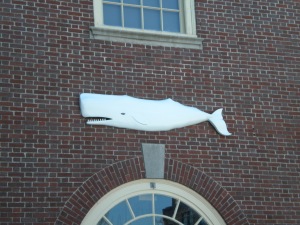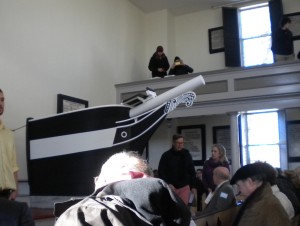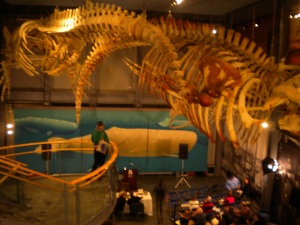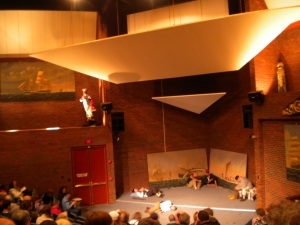I must have been growing “hazy about the eyes” this winter because I took a detour from my dissertation writing to visit the New Bedford Whaling Museum for their Moby-Dick Marathon.
The marathon began on Saturday morning, but we took our time driving the 300 or so miles North, stopping at the PEZ museum along the way (this was an unplanned stop, but as soon as I saw the sign for it, I told Brian that we NEED to stop here—for the good of all, no matter what, for God’s sake–stop the car!), and taking the scenic route along the Merritt Parkway. The Parkway was peaceful in the snow that Saturday morning—we passed stone bridges and ones with Art Nuevo designs. The PEZ museum was much less a museum and more a store, but that was fine—I took pictures and got candy.
To make a reading marathon somewhat more interesting than keeping the audience glued to chairs and eyes on the page while one of the longest novels in the English literary cannon is droned aloud, the New Bedford Whaling museum shakes things up with having a few scenes acted out, some read in different locations of the museum (like in front of an enormous whale skeleton), and a few events like artist and scholar lectures. I got to New Bedford right on time for the chapters “The Chapel,” “The Pulpit” and “The Sermon” which were the read in the Seaman’s Bethel right across the street from the whaling museum.
It is believed that the bethel was Melville’s inspiration for his “Whaleman’s Chapel” and a visit to the bethel is a really neat demonstration of how Melville blurs the lines of fiction and reality. The bethel pretty well matches the Melville’s description with black bordered plaques on the walls commemorating those lost at sea in ominous foreshadowing. But the pulpit, which must have been Melville’s invention by the look of older pictures of the bethel or an idea he imported from elsewhere, is recently made to match Melville’s description—replica of a masthead of a ship. In doing so, there’s the strange effect of reality replicating a fictional history. I was temporarily attacked by postmodernism.
Despite the very slight Disney-ification, that it was a bright and sunny day rather than stormy (I suppose that couldn’t be helped), and the fact that we were packed into the small chapel like sardines rather than the “small scattered congregation” described by the book, the reader of these chapters did his darndest to match the description of the “fine old” Father Mapple to a T—with his pauses and beseeching eyes to the heavens he was truly convincing. The whole crowd also got up, and to the melody of a harpsichord-sounding instrument, sang “The Ribs and Terrors of Whale” an appropriately depressing hymn with lines like “I saw the op’-ning maw of hell with endless pains and sorrows there.”
After the chapel, the reading continued in the museum with the backdrop of a huge pale Moby Dick mural and beneath behemoth whale skeletons hung in midair above us. The effect was that we were all at the bottom of some haunted ocean.
The reading went on, but I took a break to play Moby Dick, or the Card Game with some of the game’s creators who were there to promote it—good fun and a chance to taste part of the action as the game enacts bits of the story.
Later in the evening, after taking in more reading, a tour of the museum, and an artist lecture, I saw the chapter, “Midnight, Forecastle” performed by Culture*Park—there was accordion-playing, a staged knife fight, and antics galore.
The readings went on from there, overnight and into the next day to the final chase, but I didn’t stay for these. I floated on home with more Moby Dick swimming around in my head, which will hopefully help me craft a dissertation chapter on it.
Sitting and listening to a reading marathon seems a bit odd when you think about it—in fact, when I told my parents about the marathon my Mom laughed and said she would’ve been bored stiff—but, I was definitely entertained by the experience, through I have mixed feelings overall about a readathon’s value as a method of literary appreciation. On the pro side of the experience, having a text read aloud draws attention to the language—each word has to be pronounced and in hearing certain words read aloud I realized anew how fond Melville was of making up descriptors—not whole new words, but nominalized forms or adding –iest or –ingly on the ends of words. Also, adding to the value of the slow re-read, you have time to ponder—just sitting with the book open, not having to actively read frees your mind up to wander. This lead me to fixate on a word “slouched” a descriptor for Jonah’s hat in the Mapple speech and check that the word is used later, towards the end of the novel to describe Ahab’s hat. I hadn’t noticed that before and doubt that I would have even if I had re-read the section. Because it was read to me my mind could skim over it so readily—I had to engage it.
On the con side of a readathon is my fear that Moby Dick is merely venerated for being a long book—it’s appreciated for merely being a mountain to climb and say “I did it!” Well, what did you do? If Moby Dick is just appreciated for being a long book with a few dry parts that makes it difficult to get through, then listeners are missing what makes the book literary rather than a jumble of words on 703 pages. On the upside, it the readathon at the New Bedford whaling museum didn’t seem to do that; the readers seemed to truly, lovingly, sometimes passionately appreciate their subject, to the extent that they sometimes couldn’t contain hand gestures, props, and a touch of voice acting.
Overall, a really good experience—I’m glad I went. Maybe see you next year?





I love the New Bedford Whaling museum! It’s got an awesome historic New Englandy atmosphere; how cool it must have been to do a production of Moby Dick there. We’ll have to compare notes on the whale skeletons.
I’ve heard smarter folk than myself describe Moby Dick as a great novella hidden within a novel.
I have heard much of that sentiment myself, but I don’t buy it. Since doing more of an in-depth investigation of those mid-point chapters, I have some theories of what Melville was doing, and now I actually think those chapters on blubber, the whiteness, white types, and the squid are even more interesting than the thin skeleton of a plot Melville begins and ends with. Melville uses a lot of esoteric humor there, plays with lines between fraudulent/real/fictional information, and, I think, aims for a certain amount of “bad” writing or “blubber” to make his a sort of whale of a novel. I’ve also heard the theory that it’s a trick to demonstrate the passage of time on a whaling ship, but I don’t think it’s as simple as that–I think Melville is doing a lot of things all at once.